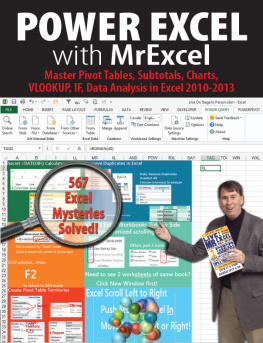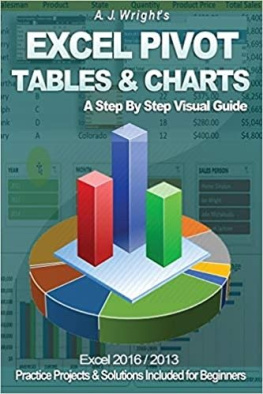Microsoft Excel 2019 Pivot Table Data Crunching
Bill Jelen
Michael Alexander

Microsoft Excel 2019 Pivot Table Data Crunching
Published with the authorization of Microsoft Corporation by:
Pearson Education, Inc.
Copyright 2019 by Pearson Education, Inc.
All rights reserved. Printed in the United States of America. This publication is protected by copyright, and permission must be obtained from the publisher prior to any prohibited reproduction, storage in a retrieval system, or transmission in any form or by any means, electronic, mechanical, photocopying, recording, or likewise. For information regarding permissions, request forms, and the appropriate contacts within the Pearson Education Global Rights & Permissions Department, please visit www.pearsoned.com/permissions/. No patent liability is assumed with respect to the use of the information contained herein. Although every precaution has been taken in the preparation of this book, the publisher and author assume no responsibility for errors or omissions. Nor is any liability assumed for damages resulting from the use of the information contained herein.
ISBN-13: 978-1-5093-0724-1
ISBN-10: 1-5093-0724-9
Library of Congress Control Number: 2018963618
Printed in the United States of America
1 18
Trademarks
Microsoft and the trademarks listed at http://www.microsoft.com on the Trademarks webpage are trademarks of the Microsoft group of companies. All other marks are property of their respective owners.
Warning and Disclaimer
Every effort has been made to make this book as complete and as accurate as possible, but no warranty or fitness is implied. The information provided is on an as is basis. The authors and the publisher shall have neither liability nor responsibility to any person or entity with respect to any loss or damages arising from the information contained in this book.
Special Sales
For information about buying this title in bulk quantities, or for special sales opportunities (which may include electronic versions; custom cover designs; and content particular to your business, training goals, marketing focus, or branding interests), please contact our corporate sales department at or (800) 382-3419.
For government sales inquiries, please contact .
For questions about sales outside the U.S., please contact .
Editor-in-Chief: Brett Bartow
Executive Editor: Loretta Yates
Sponsoring Editor: Charvi Arora
Managing Editor: Sandra Schroeder
Senior Project Editor: Tracey Croom
Project Editor: Charlotte Kughen
Copy Editor: Kitty Wilson
Indexer: Ken Johnson
Proofreader: Paula Lowell
Technical Editor: Bob Umlas
Publishing Coordinator: Cindy Teeters
Cover Designer: Twist Creative, Seattle
Compositor: Bronkella Publishing LLC
Graphics: TJ Graham Art
To Ashvina Sharma and his team at Microsoft. Thanks for Pivot Table Defaults!
Bill Jelen
To my 12 fans at datapigtechnologies.com.
Mike Alexander
Contents at a Glance
Contents
Acknowledgments
Thanks to Mike Alexander for being my coauthor on the five previous editions of this book. At Microsoft, thanks to the Excel team for always being willing to answer questions about various features. At MrExcel.com, thanks to an entire community of people who are passionate about Excel. Finally, thanks to my wife, Mary Ellen, for her support during the writing process.
Bill Jelen
Thanks to Bill Jelen for deciding to coauthor this book with me many editions ago. His knowledge of Excel still blows me away to this day. My deepest thanks to the professionals at Pearson Education for all the hours of work put into bringing this book to life. Thanks also to Bob Umlas, whose technical editing has helped us make numerous improvements to the examples and text in this book. Finally, a special thank you goes to the wife and kids for putting up with all the time I spent locked away on this project.
Mike Alexander
About the Authors
 Bill Jelen, Excel MVP and the host of MrExcel.com, has been using spreadsheets since 1985, and he launched the MrExcel.com website in 1998. Bill was a regular guest on Call for Help with Leo Laporte and has produced more than 2,200 episodes of his daily video podcast, Learn Excel from MrExcel. He is the author of 57 books about Microsoft Excel and writes the monthly Excel column for Strategic Finance magazine. Before founding MrExcel.com, Bill spent 12 years in the trenches, working as a financial analyst for the finance, marketing, accounting, and operations departments of a $500 million public company. He lives in Merritt Island, Florida, with his wife, Mary Ellen.
Bill Jelen, Excel MVP and the host of MrExcel.com, has been using spreadsheets since 1985, and he launched the MrExcel.com website in 1998. Bill was a regular guest on Call for Help with Leo Laporte and has produced more than 2,200 episodes of his daily video podcast, Learn Excel from MrExcel. He is the author of 57 books about Microsoft Excel and writes the monthly Excel column for Strategic Finance magazine. Before founding MrExcel.com, Bill spent 12 years in the trenches, working as a financial analyst for the finance, marketing, accounting, and operations departments of a $500 million public company. He lives in Merritt Island, Florida, with his wife, Mary Ellen.
Mike Alexander is a Microsoft Certified Application Developer (MCAD) and author of several books on advanced business analysis with Microsoft Access and Excel. He has more than 15 years of experience consulting and developing Office solutions. Mike has been named a Microsoft MVP for his ongoing contributions to the Excel community.
Introduction
The pivot table is the single most powerful tool in all of Excel. Pivot tables came along during the 1990s, when Microsoft and Lotus were locked in a bitter battle for dominance of the spreadsheet market. The race to continually add enhanced features to their respective products during the mid-1990s led to many incredible features, but none as powerful as the pivot table.
With a pivot table, you can transform one million rows of transactional data into a summary report in seconds. If you can drag a mouse, you can create a pivot table. In addition to quickly summarizing and calculating data, pivot tables enable you to change your analysis on the fly by simply moving fields from one area of a report to another.
No other tool in Excel gives you the flexibility and analytical power of a pivot table.
What you will learn from this book
It is widely agreed that close to 60 percent of Excel customers leave 80 percent of Excel untouchedthat is, most people do not tap into the full potential of Excels built-in utilities. Of these utilities, the most prolific by far is the pivot table. Despite the fact that pivot tables have been a cornerstone of Excel for almost 20 years, they remain one of the most underutilized tools in the entire Microsoft Office suite.
Having picked up this book, you are savvy enough to have heard of pivot tablesand you have perhaps even used them on occasion. You have a sense that pivot tables provide a power that you are not using, and you want to learn how to leverage that power to increase your productivity quickly.
Within the first two chapters, you will be able to create basic pivot tables, increase your productivity, and produce reports in minutes instead of hours. Within the first seven chapters, you will be able to output complex pivot reports with drill-down capabilities and accompanying charts. By the end of the book, you will be able to build a dynamic pivot table reporting system.











 Bill Jelen, Excel MVP and the host of MrExcel.com, has been using spreadsheets since 1985, and he launched the MrExcel.com website in 1998. Bill was a regular guest on Call for Help with Leo Laporte and has produced more than 2,200 episodes of his daily video podcast, Learn Excel from MrExcel. He is the author of 57 books about Microsoft Excel and writes the monthly Excel column for Strategic Finance magazine. Before founding MrExcel.com, Bill spent 12 years in the trenches, working as a financial analyst for the finance, marketing, accounting, and operations departments of a $500 million public company. He lives in Merritt Island, Florida, with his wife, Mary Ellen.
Bill Jelen, Excel MVP and the host of MrExcel.com, has been using spreadsheets since 1985, and he launched the MrExcel.com website in 1998. Bill was a regular guest on Call for Help with Leo Laporte and has produced more than 2,200 episodes of his daily video podcast, Learn Excel from MrExcel. He is the author of 57 books about Microsoft Excel and writes the monthly Excel column for Strategic Finance magazine. Before founding MrExcel.com, Bill spent 12 years in the trenches, working as a financial analyst for the finance, marketing, accounting, and operations departments of a $500 million public company. He lives in Merritt Island, Florida, with his wife, Mary Ellen.